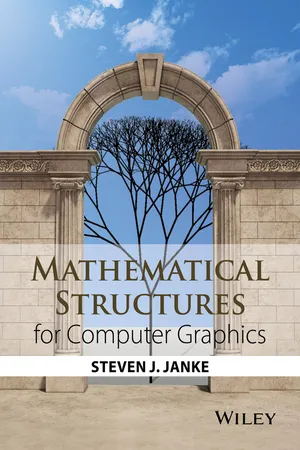
- English
- ePUB (mobile friendly)
- Available on iOS & Android
Mathematical Structures for Computer Graphics
About This Book
A comprehensive exploration of the mathematics behind the modeling and rendering of computer graphics scenes
Mathematical Structures for Computer Graphics presents an accessible and intuitive approach to the mathematical ideas and techniques necessary for two- and three-dimensional computer graphics. Focusing on the significant mathematical results, the book establishes key algorithms used to build complex graphics scenes.
Written for readers with various levels of mathematical background, the book develops a solid foundation for graphics techniques and fills in relevant graphics details often overlooked in the literature. Rather than use a rigid theorem/proof approach, the book provides a flexible discussion that moves from vector geometry through transformations, curve modeling, visibility, and lighting models. Mathematical Structures for Computer Graphics also includes:
- Numerous examples of two- and three-dimensional techniques along with numerical calculations
- Plenty of mathematical and programming exercises in each chapter, which are designed particularly for graphics tasks
- Additional details at the end of each chapter covering historical notes, further calculations, and connected concepts for readers who wish to delve deeper
- Unique coverage of topics such as calculations with homogeneous coordinates, computational geometry for polygons, use of barycentric coordinates, various descriptions for curves, and L-system techniques for recursive images
Mathematical Structures for Computer Graphics is an excellent textbook for undergraduate courses in computer science, mathematics, and engineering, as well as an ideal reference for practicing engineers, researchers, and professionals in computer graphics fields. The book is also useful for those readers who wish to understand algorithms for producing their own interesting computer images.
Frequently asked questions
Information
Table of contents
- Cover
- Title Page
- Copyright
- Dedication
- Preface
- Chapter 1: Basics
- Chapter 2: Vector Algebra
- Chapter 3: Vector Geometry
- Chapter 4: Transformations
- Chapter 5: Orientation
- Chapter 6: Polygons and Polyhedra
- Chapter 7: Curves and Surfaces
- Chapter 8: Visibility
- Chapter 9: Lighting
- Chapter 10: Other Paradigms
- Appendix A: Geometry and Trigonometry
- Appendix B: Linear Algebra
- References
- Index
- End User License Agreement